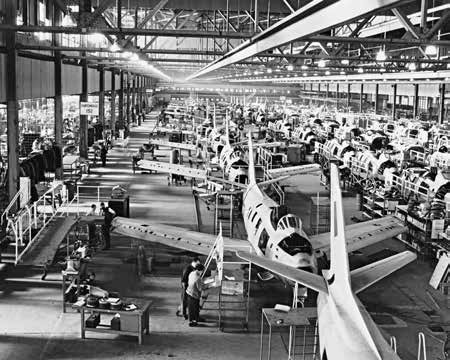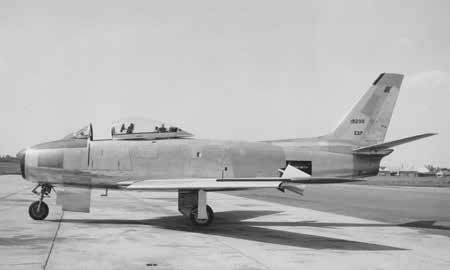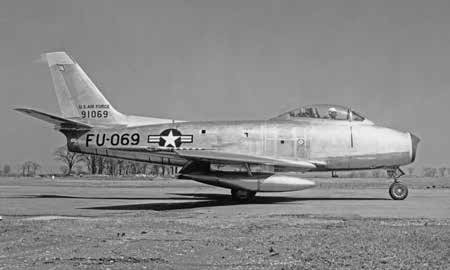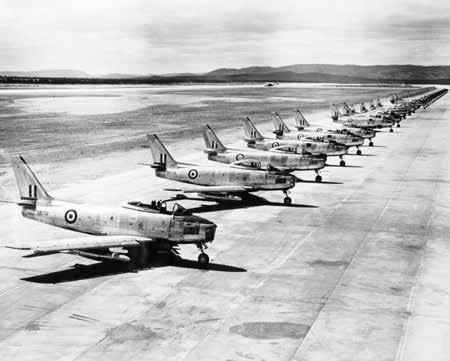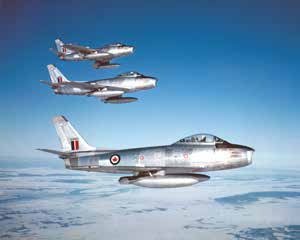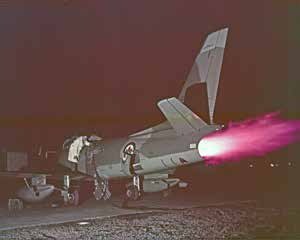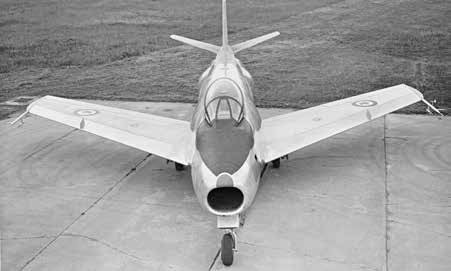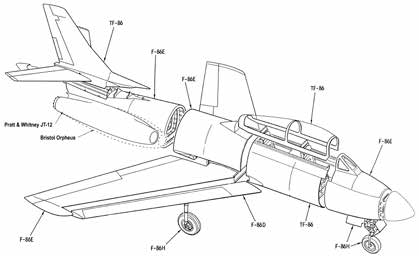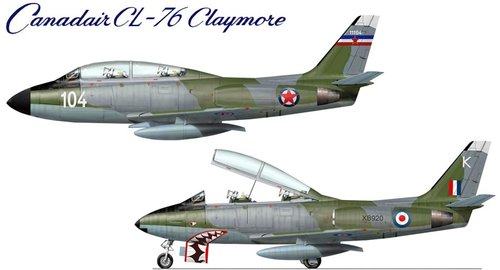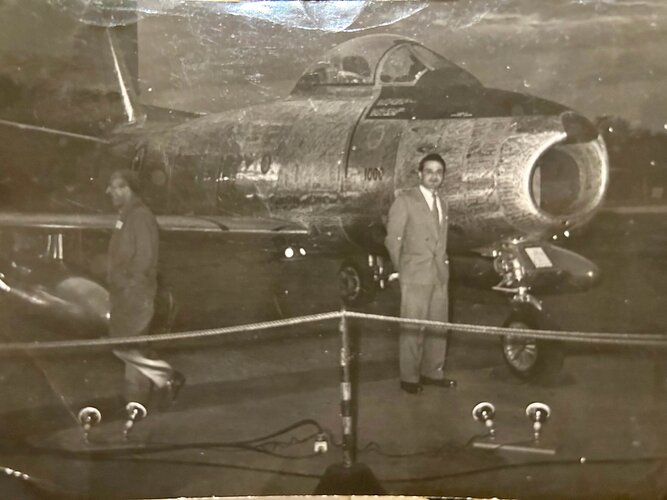- Joined
- 25 June 2009
- Messages
- 14,671
- Reaction score
- 5,854
Here's a recap of CL-13 variants, both built and unbuilt, from Bill Upton's CANADAIR CL-13B SABRE Mk 6 (published by the Canada Aviation and Space Museum):
CL-13 Sabre Mk 1c/n 1)
The first prototype CL-13 Sabre for Canada, known officially as the Sabre Mk 1, was assembled at Canadair from supplied components of a NAA F-86A-5-NA received from the United States in 1949.
Assembly tooling had to be newly manufactured by Canadair due to North American being unable to supply any production or assembly tooling with their own Sabre production line in full swing. This aircraft, powered by a 23.13 kN (5,200 lbf) thrust General Electric J47-GE-13 turbojet engine, came off the new assembly line at Canadair’s Plant 2 facility on 28 July 1950, just a year after the production contract had been signed. It soon had full RCAF markings applied, but for some reason it initially bore the unusual arrangement of the RCAF serial number on the tail as 191-010 (later changed correctly to 19101), and had the National Research Council (NRC) unit code, CK-R, on the wings and sides of the fuselage.
With Cartierville Airport’s main runway being extended due to the forethought and necessity of future jet aircraft operations at the aerodrome, the new Sabre Mk 1 jet was trucked in the early morning hours to nearby RCAF Station Dorval next to Montreal’s Dorval Airport for its premiere flight.
The singular Mk 1 aircraft, piloted by Canadair’s chief of aircraft operations, Al Lilly, performed its first flight on 8 August 1950. Two days later, Lilly became the first person to exceed the speed of sound in Canada, breaking Mach 1 in this same aircraft while flying a demonstration over the Cartierville facilities with many Canadair employees standing outside watching their new fighter jet perform.
Sabre 19101 CK-R was officially taken-on-strength by the RCAF on 11 August, and was soon assigned to the National Research Council at Arnprior, Ontario, being tested with the Central Experimental and Proving Establishment (CEPE) Detachment also located there. Wing flow studies were performed in the early 1950s with this very highly polished Sabre during low and high-speed stalls by photographing wing tufts on the flat black-painted right wing and control surfaces. This prototype Canadian Sabre, later bearing the CEPE fuselage unit code PX-101, remained attached to the NRC and followed with the detachment during subsequent relocations to RCAF Station Rockcliffe, Ontario in 1952, then on to Uplands Airport in 1953.
This first of an unprecedented, and unparalleled line of Canadair-produced aircraft, and the first Canadian-built aircraft to break the sound barrier was retired from all flying duties by October 1955. It was soon placed in storage at RCAF Station Lincoln Park in Alberta, notably being designated for future use as a museum aircraft. By August 1965, it was officially struck-off-strength, sold to No. 700 Wing (City of Edmonton) RCAF Association and put on long-term outdoor display at the Edmonton Airport, Alberta. In an effort to preclude further weathering ravages by Mother Nature, it currently resides within the safe confines of the Alberta Aviation Museum, Edmonton.
Captions:
1. The F-86A-5 fuselage and components from NAA arrived in Canadair’s receiving area in late November 1949. “CANADA” was inked by hand ahead and below the quarter-panels of the windscreen.
2. For this premiere assembly task the learning curve went remarkably smooth. Here, in front of Canadair’s Plant 2 Building B202, the unmarked prototype Sabre is seen following its simple rollout.
3. Canadair’s Alexander J. (Al) Lilly, sitting in the cockpit of the sole North American Aviation / Canadair Sabre Mk 1, RCAF serial number 191-010 CK-R, prepares for the first flight of the aircraft from Dorval Airport.
4. Pilot Al Lilly gives an impromptu post-flight briefing to Defence Minister Hon. Brooke Claxton and Air Marshall Wilf Curtis immediately following his successful first flight in the Canadair-built Sabre Mk 1.
5-6. Canadair’s Mk 1 Sabre, 191-010 CK-R, reposes for a photo shoot on the Dorval tarmac following its successful first flight.
CL-13 Sabre Mk 1c/n 1)
The first prototype CL-13 Sabre for Canada, known officially as the Sabre Mk 1, was assembled at Canadair from supplied components of a NAA F-86A-5-NA received from the United States in 1949.
Assembly tooling had to be newly manufactured by Canadair due to North American being unable to supply any production or assembly tooling with their own Sabre production line in full swing. This aircraft, powered by a 23.13 kN (5,200 lbf) thrust General Electric J47-GE-13 turbojet engine, came off the new assembly line at Canadair’s Plant 2 facility on 28 July 1950, just a year after the production contract had been signed. It soon had full RCAF markings applied, but for some reason it initially bore the unusual arrangement of the RCAF serial number on the tail as 191-010 (later changed correctly to 19101), and had the National Research Council (NRC) unit code, CK-R, on the wings and sides of the fuselage.
With Cartierville Airport’s main runway being extended due to the forethought and necessity of future jet aircraft operations at the aerodrome, the new Sabre Mk 1 jet was trucked in the early morning hours to nearby RCAF Station Dorval next to Montreal’s Dorval Airport for its premiere flight.
The singular Mk 1 aircraft, piloted by Canadair’s chief of aircraft operations, Al Lilly, performed its first flight on 8 August 1950. Two days later, Lilly became the first person to exceed the speed of sound in Canada, breaking Mach 1 in this same aircraft while flying a demonstration over the Cartierville facilities with many Canadair employees standing outside watching their new fighter jet perform.
Sabre 19101 CK-R was officially taken-on-strength by the RCAF on 11 August, and was soon assigned to the National Research Council at Arnprior, Ontario, being tested with the Central Experimental and Proving Establishment (CEPE) Detachment also located there. Wing flow studies were performed in the early 1950s with this very highly polished Sabre during low and high-speed stalls by photographing wing tufts on the flat black-painted right wing and control surfaces. This prototype Canadian Sabre, later bearing the CEPE fuselage unit code PX-101, remained attached to the NRC and followed with the detachment during subsequent relocations to RCAF Station Rockcliffe, Ontario in 1952, then on to Uplands Airport in 1953.
This first of an unprecedented, and unparalleled line of Canadair-produced aircraft, and the first Canadian-built aircraft to break the sound barrier was retired from all flying duties by October 1955. It was soon placed in storage at RCAF Station Lincoln Park in Alberta, notably being designated for future use as a museum aircraft. By August 1965, it was officially struck-off-strength, sold to No. 700 Wing (City of Edmonton) RCAF Association and put on long-term outdoor display at the Edmonton Airport, Alberta. In an effort to preclude further weathering ravages by Mother Nature, it currently resides within the safe confines of the Alberta Aviation Museum, Edmonton.
Captions:
1. The F-86A-5 fuselage and components from NAA arrived in Canadair’s receiving area in late November 1949. “CANADA” was inked by hand ahead and below the quarter-panels of the windscreen.
2. For this premiere assembly task the learning curve went remarkably smooth. Here, in front of Canadair’s Plant 2 Building B202, the unmarked prototype Sabre is seen following its simple rollout.
3. Canadair’s Alexander J. (Al) Lilly, sitting in the cockpit of the sole North American Aviation / Canadair Sabre Mk 1, RCAF serial number 191-010 CK-R, prepares for the first flight of the aircraft from Dorval Airport.
4. Pilot Al Lilly gives an impromptu post-flight briefing to Defence Minister Hon. Brooke Claxton and Air Marshall Wilf Curtis immediately following his successful first flight in the Canadair-built Sabre Mk 1.
5-6. Canadair’s Mk 1 Sabre, 191-010 CK-R, reposes for a photo shoot on the Dorval tarmac following its successful first flight.
Attachments
-
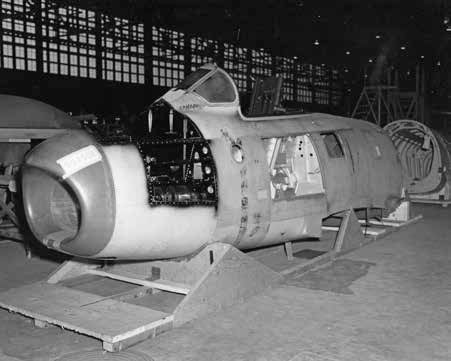 CL-13 Mk 1 fuselage.jpg31.9 KB · Views: 567
CL-13 Mk 1 fuselage.jpg31.9 KB · Views: 567 -
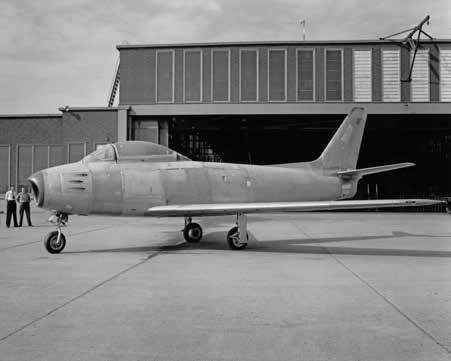 CL-13 Mk 1 unmarked.jpg23.6 KB · Views: 467
CL-13 Mk 1 unmarked.jpg23.6 KB · Views: 467 -
 CL-13 Mk 1 preparing for first flight.jpg19.1 KB · Views: 450
CL-13 Mk 1 preparing for first flight.jpg19.1 KB · Views: 450 -
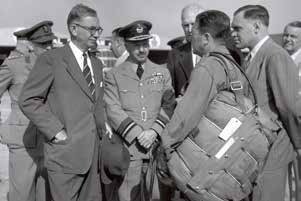 CL-13 Mk 1 pilot Al Lilly gives a post-flight briefing.jpg15.8 KB · Views: 439
CL-13 Mk 1 pilot Al Lilly gives a post-flight briefing.jpg15.8 KB · Views: 439 -
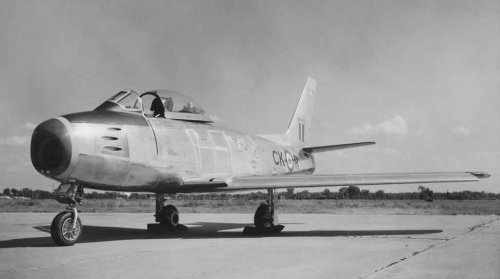 CL-13 Mk 1 photo shoot on Dorval tarmac.jpg39.7 KB · Views: 441
CL-13 Mk 1 photo shoot on Dorval tarmac.jpg39.7 KB · Views: 441 -
 CL-13 Mk 1 on snow.jpg33.2 KB · Views: 71
CL-13 Mk 1 on snow.jpg33.2 KB · Views: 71
Last edited by a moderator:

